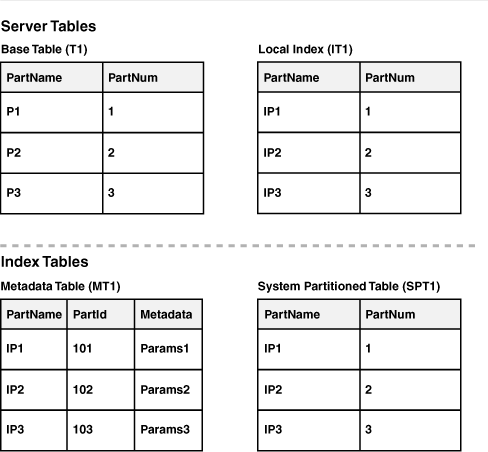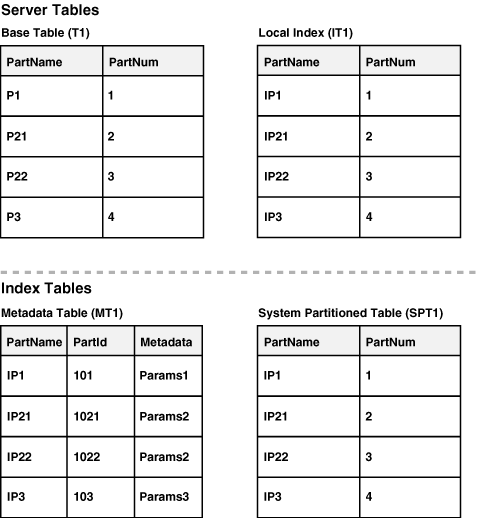Home / Using System-Managed Domain Indexes
Using System-Managed Domain Indexes
This section describes how system-managed domain indexes work, how to collect and store statistics for them, and lists restrictions for use.
Let us examine how system-managed domain indexes work.
Figure 8-1 illustrates the initial setup of a base table T1. T1 has the following elements:
- three partitions
- a local domain index on one of its columns, IT1
- a table of corresponding metadata objects, MT1, which is the optional metadata table created by the indextype to store information specific to each partition of the local domain index
- a system-partitioned table, SPT1, created by the indextype to store index data
The structures shown in these tables (table T1, index IT1 and the system partitioned table SPT1) have the same number of partitions, in a one-to-one relationship. The metadata table MT1 has as many rows as the number of partitions in these tables.
Figure 8-1 Three-Partition Table with a Local Domain Index, and Associated Structures

Description of "Figure 8-1 Three-Partition Table with a Local Domain Index, and Associated Structures"
Figure 8-2 illustrates what happens to T1 and its related structures after splitting one of its partitions with the operation in Example 8-21:
Example 8-21 Splitting an Existing Table Partition
ALTER TABLE T1 SPLIT PARTITION P2 INTO P21, P22
- the partition P2 in the base table T1 splits into P21 and P22
- in the local domain index, partition IP2 is dropped and two new partitions, IP21 and IP22, are created
- the indextype invokes the ODCIIndexUpdPartMetadata() method that makes the necessary updates to the metadata table MT1
- in the system partitioned table SPT1, the partition that corresponds to partition IP2 is dropped and two new partitions are created
- index partitions are marked UNUSABLE as a result of the split operation; they must be rebuilt to make them USABLE
Figure 8-2 A Three-Partition Table after ALTER TABLE SPLIT PARTITION

Description of "Figure 8-2 A Three-Partition Table after ALTER TABLE SPLIT PARTITION "
<< Using System Partitioning
Designing System-Managed Domain Indexes >>

